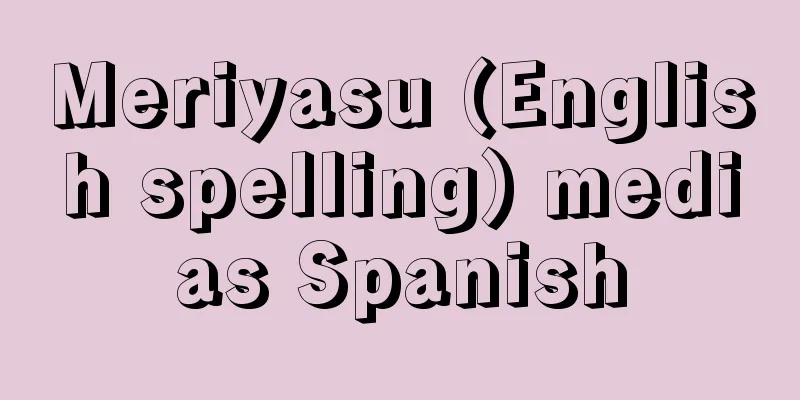Meriyasu (English spelling) medias Spanish

|
While woven fabrics are made with straight warp and weft threads, knitted fabrics (also called knits) are made from a collection of stitches (loops) created by bending the threads to form a cloth-like shape. In terms of the stitch structure, they are classified into those knitted horizontally (weft knitted fabric) and those made by arranging the warp threads and creating stitches with adjacent warp threads (warp knitted fabric). All knitted fabrics made with knitting needles, known as hand knitting, are weft knitted fabric. The origins of knitted fabric are very ancient, and can also be seen in Egyptian Coptic weaving, but it wasn't until 1589 that it began to be made by machine, when William Lee invented the sock knitting machine. This is a machine that is operated by stepping on the material like a hand loom and knits the material by hand, and can be said to be the prototype of modern home knitting machines. It was introduced to Japan in the early Edo period, brought by the Portuguese and Dutch when they arrived in Japan. The word "meriyasu" is said to be a corrupted version of the Spanish word "medias" (meaning socks). In Japan, it is written as "enormous small" and pronounced "meriyasu", and the word comes from the fact that there is no big or small, in other words, it fits perfectly. Recently, the word "knit" has been used to refer to all knitted products. Nowadays, any type of yarn is suitable for knitting, including cotton, wool, silk, and synthetic yarns, but generally, soft, fluffy, and elastic yarn is required. There are two types of needles for knitting machines: whisker needles and flip-top needles, but most knitting machines today use flip-top needles. The knitting sequence with flip-top needles is as follows: (1) The needle is raised to open the flip-top and the yarn is replenished. (2) The needle is lowered, so the loop slides upward and closes the flip-top. (3) The needle is lowered further, breaking through the loop and completing a new stitch. Then the needle begins to rise as in (1), and the next yarn is replenished. The main uses for knitting are socks, underwear, outerwear, gloves, hats, and more, and it is used in almost all of the items we wear. [Namiki Satoru] ©Katsuya Nishikawa "> Knitted stitch structure ©Katsuya Nishikawa "> Knitting sequence for stockinette stitches (Bracket needle) Source: Shogakukan Encyclopedia Nipponica About Encyclopedia Nipponica Information | Legend |
|
織物が経緯(たてよこ)の直線の糸でつくられているのに対し、メリヤス(ニット、編物ともいう)は、糸の屈曲による編目(ループ)の集合によって布状をなすものをいう。編目の構造からみて、横方向へ編成するもの(緯(よこ)メリヤス)と、整経して隣どうしの経糸(たていと)と編目をつくるもの(経(たて)メリヤス)とに分類される。手編といわれる編棒でつくるメリヤスは、すべて緯メリヤスである。 メリヤスの起源は非常に古く、エジプト・コプト織にもみられるが、機械でつくられるようになったのは1589年、ウィリアム・リーWilliam Leeが靴下編機を考案したのに始まる。これは手織(ており)機のように足踏みで動かし、手で編み上げる仕掛けで、現在の家庭編機の原型ともいえる。日本に伝来したのは江戸初期、ポルトガル人やオランダ人が来日したときに持ち込んだものが伝えられた。メリヤスという語はスペイン語のメディアスmedias(靴下の意味)がなまったものといわれる。日本では「莫大小」と書いてメリヤスと読み、意味は、大小なし、すなわちぴたりとフィットすることから出たことばである。最近はニットということばがメリヤス全製品に使われている。 現在はメリヤスに都合のよい糸として、綿糸、毛糸、絹糸、化繊糸など、なんでも使われるが、一般に柔らかくふっくらして弾力ある糸が要求される。編機の編針には、ヒゲ針とベラ針の2種類あるが、現在の編機はほとんどベラ針である。ベラ針による編成順序を示すと、次のようになる。〔1〕針が上にあげられベラが開き、これに糸を補給する。〔2〕針が下に下げられるために、ループが上方に滑ってベラを閉じる。〔3〕針がさらに下げられてループを抜け出し、新しい編目を完成する。そして〔1〕のように針の上昇が始まり、次の糸が補給される。メリヤスのおもな用途をあげると、靴下類、肌着類、上着類、手袋類、帽子類その他となり、身の回りのほとんどに使われている。 [並木 覚] ©西川勝也"> メリヤスの編目構造 ©西川勝也"> メリヤスの編成順序(ベラ針) 出典 小学館 日本大百科全書(ニッポニカ)日本大百科全書(ニッポニカ)について 情報 | 凡例 |
Recommend
urinary acariasis
…Dermatitis includes vanillism, copra itch, baker...
Bremond, Henri
Born: July 31, 1865 in Aix-en-Provence [Died] Augu...
Spodosols
…soils that typically develop under boreal forest...
Kagakuji Temple - Science Lottery
A Soto Zen temple in Ako City, Hyogo Prefecture. T...
Cistus
...An evergreen shrub of the Cistaceae family, ab...
Happu Kaido - Happu Kaido
A highway crossing the Suzuka Mountains connecting...
Biscuit beetle
...Drugstore beetles, cigarette beetles, and othe...
Cyclotetramethylenetetranitramine
HMX is also called octogen. It is very similar to ...
Tong-jian ji-shi ben-mo; T`ung-chien chi-shih pên-mo
China's first chronicle-style historical work....
Flaubert
French author. Born in Rouen in Normandy as the so...
Open set - Kaishuugou (English spelling) open set
A set S is said to be open if all points in S are ...
Nanryu Tanabe
He has been a storyteller since the end of the Edo...
Asian Peace Association
…After returning to Japan, he made a speech entit...
Interdict (English spelling)
In the Catholic Church, an interdict is a punishme...
Antime Conviction - Antime Conviction
...It is a judicial term related to the evaluatio...









